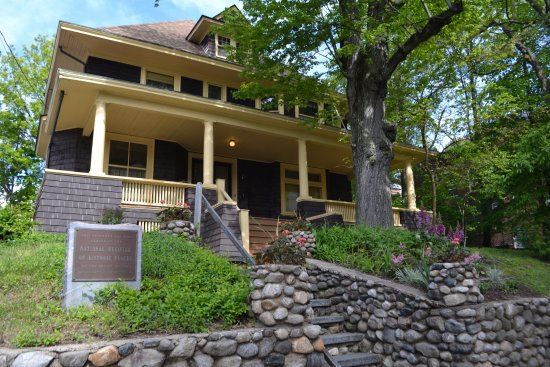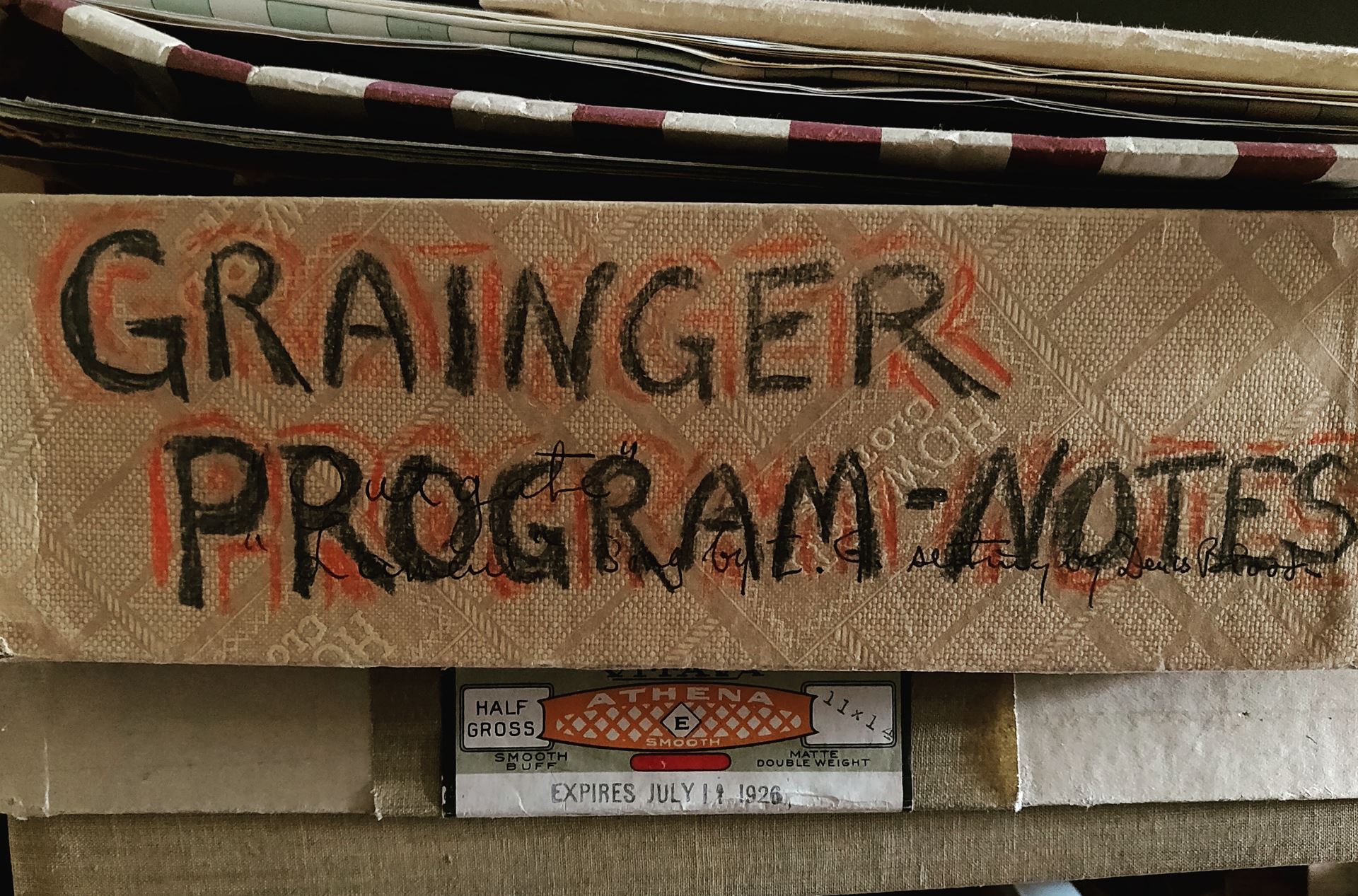 by Susan Edwards Colson
by Susan Edwards Colson
In addition to the Grainger music and legacy, there is the house itself. The Percy Grainger House, 7 Cromwell Place, White Plains, is a stunning time capsule. It is an increasingly popular tourist destination, with the certainty of an immersive visit to a bygone era for delighted visitors. It is also a hold out, a 19th century house left standing in a rapidly modernizing, urban neighborhood.
The house is filled with Percy’s things and Ella’s things too, in dusty choc-a-block stacks. Visitors comment on Percy’s extreme organization of scores and letters, box after box, and Ella’s softer approach to her own poems and sketches, tied together with a pink ribbon or two.  Going through a closet now with several years of sorting experience, I feel an intuitive sense of who might have packed what when. Who cherished it, then eventually forgot it? Ella, probably. Who noticed it late in life, then, touched by the memory, added a note of explanation? Ella, certainly. Who deemed it important enough to be packed away wrapped in the October 5, 1930 New York Times edition announcing that CBS had broadcast the New York Philharmonic live over the radio for the very first time that day? Percy, no doubt.
Going through a closet now with several years of sorting experience, I feel an intuitive sense of who might have packed what when. Who cherished it, then eventually forgot it? Ella, probably. Who noticed it late in life, then, touched by the memory, added a note of explanation? Ella, certainly. Who deemed it important enough to be packed away wrapped in the October 5, 1930 New York Times edition announcing that CBS had broadcast the New York Philharmonic live over the radio for the very first time that day? Percy, no doubt.
Preservation of the house is truly important. The IPGS board of late lives and breathes the three R’s of historic houses: rehabilitation, restoration and reconstruction. Rehabilitation is our first challenge, balancing the need to update the house to meet changing uses while retaining the property's historic character. Restoration will dictate that we depict the Grainger House at a particular place in time, packing away evidence of other periods, to tell the Grainger story in an understandable way. Reconstruction will establish a coherent interpretation, item by item.
This is an enormous undertaking! We are grateful to those who have believed in us, invested in us, and coached us along the way. Early on, the Greater Hudson Heritage Network’s Needs Assessment Program sent site preservation experts to survey the collection. Their careful, thoughtful, recommendations initiated deep reflection and sent us in the right direction.

In 2015, the Museum Association of New York provided a grant that allowed the IPGS board to engage its long time members, friends and board to complete a Strategic Plan. This plan has guided the house reconstruction and helped shape our plans for a celebration of Percy Grainger’s 100th year in White Plains.
The Documentary Heritage and Preservation Services of New York provided an Archival Needs Assessment that thoroughly examined our program, identified and addressed specific needs, operational efficiencies, facility and storage concerns, and collection management issues. The assessment pinpointed problems, recommended solutions, set priorities, and helped guide the development of our archival program. Their follow-up 2018 grant allowed us to buy software to organize our collection, and a large scanner for documentation.
 A Technical Assistance Grant (“TAG”) from the Preservation League of New York State allowed us to complete a building condition survey with the help of architect Joanne Tall of KamanTall Architects. The technical survey focuses on the windows and exterior doors providing essential information for stewardship of the house.
A Technical Assistance Grant (“TAG”) from the Preservation League of New York State allowed us to complete a building condition survey with the help of architect Joanne Tall of KamanTall Architects. The technical survey focuses on the windows and exterior doors providing essential information for stewardship of the house.  Joanne’s thoughtful observations and helpful insights to the building structure will continue to inform the restoration plan for the entire house. There are serious considerations concerning the Percy Grainger House’s historic character as well as any intended use. She was also instructive about alterations needed to meet accessibility requirements under the Americans with Disabilities Act of 1990 and the concern of visual change to our historic building. (The Technical Assistance Grant Program is made possible by the New York State Council for the Arts with the support of Governor Andrew Cuomo and the New York State Legislature. Generous additional support for this project has been provided by the Hudson River Valley National Heritage Area.)
Joanne’s thoughtful observations and helpful insights to the building structure will continue to inform the restoration plan for the entire house. There are serious considerations concerning the Percy Grainger House’s historic character as well as any intended use. She was also instructive about alterations needed to meet accessibility requirements under the Americans with Disabilities Act of 1990 and the concern of visual change to our historic building. (The Technical Assistance Grant Program is made possible by the New York State Council for the Arts with the support of Governor Andrew Cuomo and the New York State Legislature. Generous additional support for this project has been provided by the Hudson River Valley National Heritage Area.)
An essential, practical question for the IPGS board is: Will the building be used strictly to house the collection and limited to interpretive tours, or will it be given a new and expanded use? We hope that any such expansion can make full use of the historic house without compromising its historic character. We work to achieve this balance and make it so.